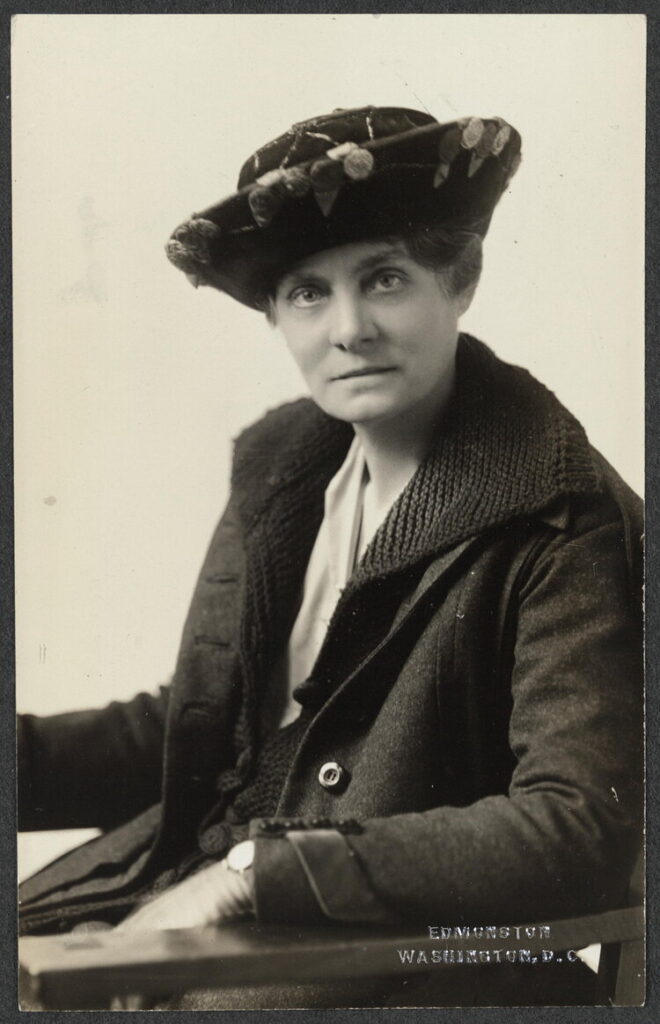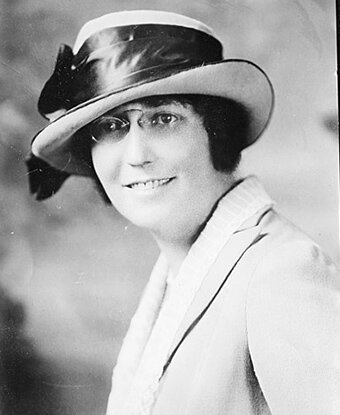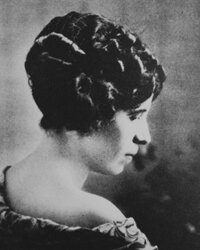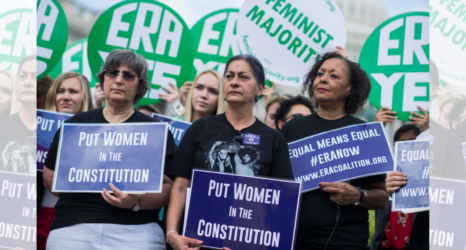This post was originally published by the Women’s Suffrage Centennial Commission (WSCC), and is republished here with permission. The WSCC is an agency of the federal government, and the publication of this post does not imply any type of partnership or relationship with the WSCC, and it does not imply WSCC’s endorsement of this outlet and its communications.
At three o’clock on an October afternoon in 1915, the suffragists of Santa Fe, New Mexico, took to the streets of the capital city to make “a public act of faith in the cause of woman suffrage.”
One hundred and fifty women joined the parade, Anglos (the term New Mexicans used to refer to whites) and Hispanics (which referred to the Spanish-speaking citizens of the state). Some marched; others rode in gaily decorated automobiles.
Mrs. Trinidad Cabeza de Baca, whose family owned one of the first autos in the city, lent hers to the cause. She was joined by a number of other Hispanic women, including Dolores “Lola” Armijo, Mrs. James Chavez, Aurora Lucero, Anita (Mrs. Secundino) Romero, Arabella (Mrs. Cleofas) Romero and her daughter, Marie.

These women were all members of powerful Hispanic families in the state; many of their fathers and husbands were well-connected politicians. Most spoke Spanish as well as English. Some of them described themselves as housewives, others were professionals. Lola Armijo was the first female member of the state government, having been appointed as state librarian in 1912.
Though the governor tried to replace her with a man, arguing that under the state constitution women could not be elected to office, a court upheld her appointment. Although she was not reported as present at the parade that day, Adelina “Nina” Otero-Warren, the first female superintendent of schools in Santa Fe was also a well-known Hispanic suffragist in the state.
The story of these New Mexicans reminds us of the diversity of suffrage activism in the United States. Their advocacy for the vote grew out of their insistence that Spanish-Americans, as they called themselves, were equal citizens.
At a moment when the land rights, religion, and language of Hispanics were under attack, they asserted that the suffrage movement needed to include them and their concerns. Spanish-speakers constituted more than half of the population of the state and held political power as voters.
Their position as economically secure and politically connected Hispanic women made them a force to be reckoned with. White suffragists therefore listened to them and incorporated their ideas, offering a model of cooperation for today’s multicultural society—though it is vital to note that Native American women in New Mexico were not included in this cooperation.
The suffrage marchers in Santa Fe deliberately took up space as they traced the political geography of New Mexico’s capital city. They began just off the plaza in the center of town, bounded by the old Palace of the Governors, the former site of Spanish and then Mexican power.
They then marched south, circling the state capital building before heading back towards the center of town, across the plaza and north around the federal building. Hundreds of people turned out to watch them make their statement in support of women’s voting rights.
The parade coincided with a visit from Mrs. Ella St. Clair Thompson, an organizer from the National Woman’s Party (NWP, known until 1916 as the Congressional Union). The NWP had been founded by Alice Paul and focused on securing an amendment that prohibited voting discrimination based on sex. Unlike women in the rest of the American West, suffragists in New Mexico focused on a national amendment, rather than a state law.
Although they had fought for full suffrage to be included in the constitution when New Mexico became a state in 1912, they had been unsuccessful.
Also, in order to protect the Spanish language provisions and religious freedoms for Catholics written into the document, the members of the constitutional convention had deliberately made the constitution extremely hard to amend. Any changes required the votes of two-thirds of the legislators, followed by three-fourths voter approval in each county. While the men of the convention had included women’s voting rights in school elections in the constitution, women could not vote in other elections.

The NWP organizers who came to New Mexico recognized the importance of working with Spanish-speaking women, whose communities held a great deal of political power. They listened to leaders like Aurora Lucero, daughter of the first secretary of state and a well-known author and advocate of bilingualism, and educator Nina Otero-Warren, who told them that the suffrage campaign also needed to address Spanish-speaking women. They insisted that the campaign include bilingual publications and speeches, often helping with the translations.
As Lucero once stated, “I speak for the Spanish American women who, while conservative, want the best possible laws where their home life is the question at issue.”
Indeed, like many Anglo women, Hispanic suffragists argued that the Spanish-speaking women of the state wanted the vote to advocate for policies that would help women and children, including education, health, and welfare policies.
They also insisted on the value of the Spanish language at a time when many Anglos wanted to do away with it because they believed it was “un-American.” It was precisely those ethnocentric attitudes that had resulted in Hispanic politicians insisting that language and religious rights be protected in the state constitution.
Hispanic suffragists were proud advocates of their language and culture. They also knew that without their help, suffrage could not be successful in their state.

The 1915 Santa Fe suffrage parade is a good example of American women’s cooperation across ethnic lines. They concluded the march at the house of U.S. Senator Thomas Catron (R-NM), a notorious anti-suffragist.
They had designated four women—two Anglos and two Hispanic women, the latter Aurora Lucero and Arabella Romero—to give speeches formally asking the Senator to support the federal amendment when he returned to Washington. He declined and lectured the women at great length on why they were wrong to demand the vote. Nevertheless, their cause gained great visibility in the capital and in the press coverage.
The next year, New Mexican women formed an official state branch of the NWP and elected Nina Otero-Warren as state vice-chair. When the first chair stepped down, Otero-Warren took her place at Alice Paul’s request.
Otero-Warren was politically well-connected and respected throughout the state for her educational work. Her father had been an influential local leader before he had been murdered by Anglo squatters on his land grant. Her stepfather’s later political appointment brought her family to live in Santa Fe where her maternal uncle was a major politician who had played a key role during the state constitutional convention. She used those connections in her fight for suffrage and also played a key role in ensuring that the state legislature ratified the 19th Amendment in February 1920.
Although it had seemed like certain victory, there was a last-minute difficulty with wavering legislators. Otero-Warren fiercely lobbied, using her new position as chair of the GOP state women’s committee to caucus with legislators and discipline their votes.
It is important to note that the 19th Amendment enfranchised both Anglo and Hispanic women in New Mexico, but not the Native women of the state. Native women and men were citizens of their own Indigenous nations, but the United States considered most Native people the legal wards of the federal government and therefore not U.S. citizens.
Moreover, even after the Indian Citizenship Act of 1924, which made all Native people U.S. citizens, New Mexican courts ruled that Indians living on reservation land remained under guardianship and were thus ineligible to vote. This did not change until 1948 when a Miguel Trujillo, Jr., of Isleta Pueblo, a veteran of World War II, sued for his right to vote and won.
After ratification of the 19th Amendment, the Democrat and Republican parties in New Mexico appealed to newly enfranchised female voters by nominating women to run for office. Otero-Warren’s experience as a suffrage campaigner and her family’s strong political connections prompted the Republican party to nominate her as their Congressional candidate in 1922.
Her campaign made national headlines, beginning when she beat the male incumbent in the primary, though she narrowly lost in the main election. That same year the Democrats also nominated two women, one Anglo and one Hispanic, for state office. Their candidate for secretary of state, Soledad Chávez de Chacón, won, becoming the first woman in the nation to win election for that office.

The experience of New Mexican Hispanic women was unusual. The demographics of New Mexico gave Spanish-speakers a political advantage they did not have in other states. The result has been that New Mexico has a long tradition of electing Hispanic women, including the first two Hispanic women governors: Republican Susana Martinez (2011-2019) and Democrat Michelle Lujan Grisham (Incumbent). In contrast, Mexican-Americans in Texas did not have the same political clout. Moreover, most of them were poor sharecroppers who were disenfranchised by Jim Crow laws, like the poll tax as well as extra-legal threats of violence.
New Mexico’s Hispanic women’s advocacy of suffrage and their work with the National Woman’s Party reminds us that Spanish was also a language of suffrage. Armed with economic security and the political clout of long-established Spanish-speaking families, New Mexico’s Hispanic women represented a formidable political force.
Without New Mexico as one of the thirty-six states that ratified the Amendment, it may well not have passed. And the state’s vote to ratify would not have happened without the support of the Hispanic community or the advocacy work of Hispanic suffragists.





